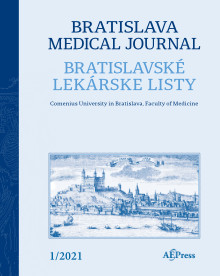Journal info
|
||||
Select Journal
Journals
Bratislava Medical Journal 2024 2023 2022 2021 2020 2019 2018 2017 2016 2015 2014 2013 2012 Ekologia - Ecology Endocrine Regulations General Physiology and Biophysics Neoplasma Acta Virologica Studia Psychologica Cardiology Letters Psychológia a patopsych. dieťaťa Kovove Materialy-Metallic Materials Slovenská hudba 2025Webshop Cart
Your Cart is currently empty.
Info: Your browser does not accept cookies. To put products into your cart and purchase them you need to enable cookies.
Bratislava Medical Journal Vol.113, No.7, p.417–420, 2012 |
||
| Title: Utility of venous compression in deep venous thrombosis evaluation revisited | ||
| Author: E. Kocakoc, S. Bhatt, V. S. Dogra | ||
| Abstract: Objective: Ultrasound venous compression (UVC) is considered the gold standard for confirmation of deep venous thrombosis (DVT) of the lower extremities. The objective of this study was to assess the contribution and significance of venous compression in comparison to color flow duplex (CFD) ultrasonography alone in the diagnosis of DVT. Methods: Retrospective analysis was performed of all DVT studies during two years period. DVT examinations were performed with a 5.8–7.6 MHz linear broadband transducer following the American Institute of Ultrasound in Medicine guidelines for the performance of DVT examination. The images were categorized as normal, partial thrombus, or complete thrombus. Results: A total of 428 patients comprised the study group. In total, 467 DVT examinations were performed (39 patients had bilateral examinations). Of the lower extremity examinations, 347/467were normal and 120/467 were abnormal. Complete thrombus was evident in 49/120 patients, while 71/120 patients had partial thrombus. We observed the thrombus on gray scale imaging in all 120 positive patients. No patient had venous compression negative for thrombus and CFD positive for thrombus. There was one patient with visualization of thrombus on gray scale imaging and complete venous compression (negative for thrombus). CFD examination of this patient was also negative for thrombus. Conclusion: UVC did not provide any additional information for the diagnosis of DVT. If CFD demonstrates the presence of DVT, venous compression is not necessary, although it can further confirm the presence of DVT. No additional DVTs were diagnosed by using venous compression alone (Tab. 2, Fig. 2, Ref. 27). |
||
| Keywords: deep venous thrombosis, Color flow, Doppler, venous compression ultrasonography, ultrasound, veins, DVT | ||
| Year: 2012, Volume: 113, Issue: 7 | Page From: 417, Page To: 420 | |
| doi:10.4149/BLL_2012_094 |
||
|
|
 download file download file |
|

